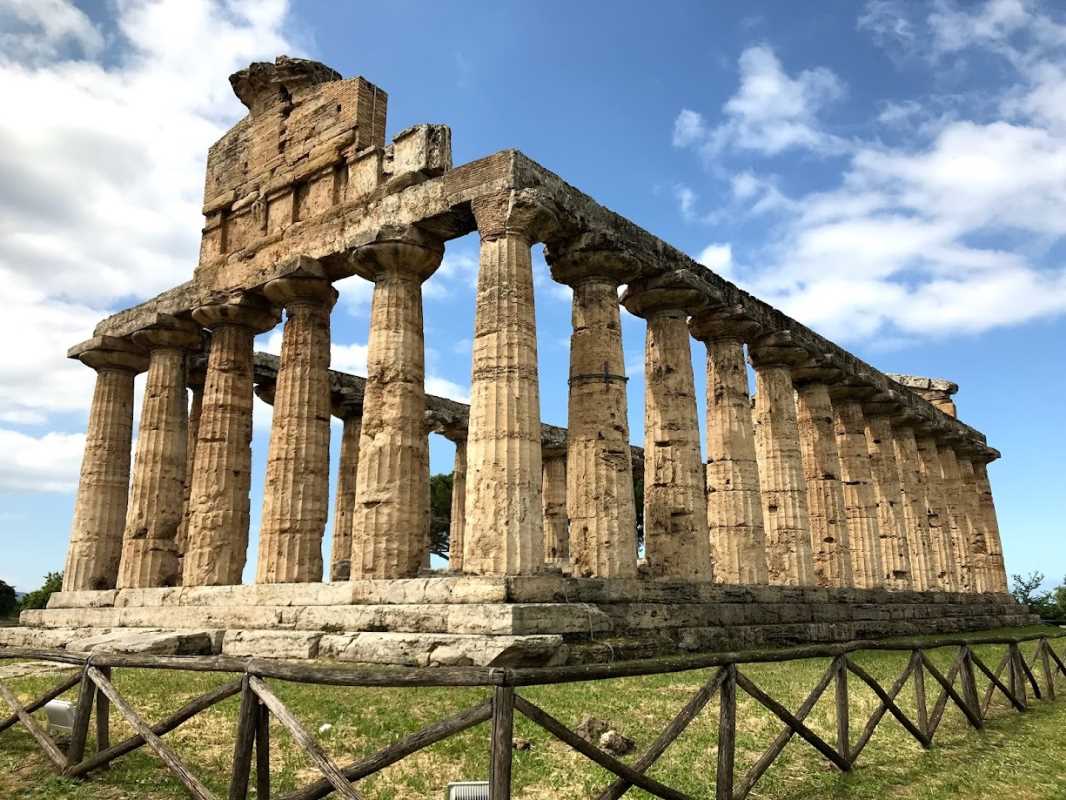The ancient ruins of Paestum, located in southern Italy, are a remarkable testament to the grandeur of Greek civilization in a land long associated with Roman legacy. Once known as Poseidonia in honor of the sea god Poseidon, this ancient city offers visitors an unparalleled opportunity to explore some of the best-preserved Greek temples in the world, alongside a wealth of fascinating historical and cultural landmarks. From its Greek origins through its Roman era transformation, Paestum holds a unique place in history that continues to captivate travelers and history enthusiasts alike.
A Brief History of Paestum
Paestum was founded by Greek settlers from Sybaris around 600 BCE. Originally named Poseidonia, after the god Poseidon, the city thrived as a vital trade hub given its strategic location near the Gulf of Salerno. The Greeks turned the city into a beacon of art, culture, and religious devotion, erecting monumental temples that remain standing to this day.
Around 273 BCE, the Romans took control of the city, renaming it Paestum. While they left many of the Greek structures intact, they added their own architectural flourishes, such as roads, amphitheaters, and public baths. Over time, however, the city’s importance waned due to environmental changes, including the spread of malaria in the surrounding swampy lands, leading to its gradual abandonment during the Middle Ages.
Rediscovered in the 18th century, Paestum has since been hailed as one of the most significant archaeological sites in Italy. Its three iconic Doric temples are a point of pride for historians and a wonder for those who marvel at ancient architecture.
The Temples of Paestum
Among the site’s most awe-inspiring attractions are three colossal Doric temples. These structures provide visitors with an intimate glimpse into the religious and cultural life of ancient Greeks and are celebrated for their astounding level of preservation.
1. Temple of Hera (Basilica)
The Temple of Hera is the oldest of the three main temples, built around 550 BCE. Known initially as the "Basilica" due to a historical error mistaking it for a Roman civic building, this impressive structure was actually dedicated to Hera, the Greek goddess of marriage and women.
With its 18 columns lining the longer sides and graceful proportions, the temple exemplifies early Doric architecture. The sturdy limestone structure contrasts with the delicate artistry of its design, a hallmark of the transition period of Greek temple construction. Visitors today can walk around the temple's perimeter and admire its detailed column fluting and colossal scale, marveling at a building that has withstood the test of time for more than 2,500 years.
2. Temple of Athena (Temple of Minerva)
Constructed around 500 BCE, the Temple of Athena shows a slight evolution in architectural style compared to the older Temple of Hera. Perched on a small rise, this temple is notable for its harmonious blend of pre-classical features and more innovative architectural elements.
Originally dedicated to Athena, the goddess of wisdom and warfare, this structure was often used as a communal place of worship and intellectual gathering. During the Christian era, it was converted into a church, a factor that contributed to its preservation over the centuries.
The combination of Doric and Ionic elements makes the Temple of Athena particularly intriguing. Visitors will notice the slender columns in the inner sanctuary and the detailed pediments, which are still visible despite centuries of exposure to the elements.
3. Temple of Neptune (Poseidon)
The Temple of Neptune, or Poseidon, towers as the largest and best-preserved of the three temples. Built in the mid-5th century BCE, during the peak of Greek architectural refinement, it is widely considered a masterpiece of Doric design.
Dedicated to the sea god Poseidon (and later mistakenly associated with Hera as well), this temple dazzles visitors with its imposing structure and harmonious proportions. Twenty-four massive columns form the perimeter, crowned with carved capitals that have survived the ages.
Walking through the temple, you can’t help but feel a sense of reverence. Whether viewed under the golden hues of a sunset or the bright midday sun, the Temple of Neptune is an unforgettable sight and a hallmark of human ingenuity and devotion.
Exploring the Archaeological Site
The ruins of Paestum stretch beyond the temples and include fascinating remnants of the larger ancient city. Here are some aspects of the site that visitors should not miss:
- The Roman Amphitheater: Reflecting Paestum’s Roman era, this oval arena was once used for gladiatorial games and public entertainment. Although partially buried, it offers an evocative glimpse of life in Roman times.
- The City Walls: Stretching over four miles, these well-preserved fortifications provide an excellent sense of Paestum’s layout and strategic planning.
- The Tomba del Tuffatore (Tomb of the Diver): Housed in the adjacent National Archaeological Museum of Paestum, this unique example of Greek fresco painting depicts a man diving into the water, thought to symbolize the passage between life and death.
The sprawling site invites exploration, with paths leading visitors through grassy fields dotted with ancient ruins and wildflowers.
Tips for Visiting Paestum
To make the most of your visit to Paestum, it’s helpful to plan ahead. Here are some practical tips:
1. Best Time to Visit
Paestum is less crowded than Rome’s ruins, but visiting during off-peak times like spring or autumn ensures a more serene experience. Summers can be hot, so aim for morning or late afternoon visits if traveling during this season.
2. Tickets and Access
Tickets can be purchased upon arrival, but booking online in advance can save time. Combination tickets often include entry to both the archaeological site and the National Archaeological Museum, which is worth visiting for its exquisite artifacts.
Wear comfortable walking shoes, as the terrain can be uneven, and don’t forget a hat and sunscreen for protection against the southern Italian sun.
3. Guided Tours
Opting for a guided tour or an audio guide enriches the experience. Knowledgeable guides help paint a vivid picture of life in ancient Paestum, explaining the symbolic and cultural significance of the various structures.
Both group and private tours are available, often departing from nearby cities like Naples or Salerno.
4. Nearby Attractions
Paestum is close to the Amalfi Coast, making it an ideal day trip destination. The surrounding countryside is also famous for its buffalo mozzarella, which you can sample at local farms. Don’t miss an opportunity to indulge in regional cuisine during your visit!
Final Thoughts
The ancient ruins of Paestum are an Italian gem that offer visitors a rare chance to walk among the vestiges of both Greek and Roman civilizations. The grand temples of Hera, Athena, and Neptune stand as enduring reminders of the ingenuity, artistry, and spirituality of ancient builders.
Whether you’re a history enthusiast, an architecture lover, or simply a traveler seeking awe-inspiring experiences, Paestum is guaranteed to leave a lasting impression. By taking the time to explore this extraordinary site, you’ll not only gain insight into ancient history but also form a deeper appreciation of its legacy in the modern world.
Prepare to lose yourself in the timeless beauty of Paestum—one of Italy’s most unique and unforgettable archaeological treasures.







